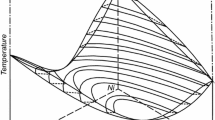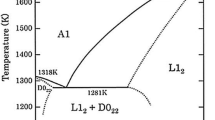Conclusions
-
1.
The primary crystallization structure of Mo-W alloys can be observed by scanning-electron microscopy. It could not be revealed by other methods. The main constituents of this structure are cells and cellular dendrites.
-
2.
The primary dendritic axis has a variable chemical composition along its length, which is caused by its discontinuous growth.
-
3.
There is an interrelationship between the primary crystallization structure and the degree of the intracrystalline segregation, which develops more intensively for cellular growth than when cellular dendrites are formed.
-
4.
Variation in the boron content in alloys of the Mo-W system almost does not have any effect on the degree of development of intracrystalline segregation of W in Mo.
Similar content being viewed by others
Literature cited
N. V. Ageev, D. V. Ignatov, and M. M. Kantor, "Texture of columnar crystals and the crystallographic orientation of dendrites in molybdenum alloys," Dokl. Akad. Nauk SSSR,184, No. 5, 1088–1090 (1969).
N. V. Ageev, D. V. Ignatov, M. S. Model', et al., "Effect of carbon distribution on the structure of molybdenum and its alloys," in: Alloying and Properties of High-Temperature-Strength Alloys [in Russian], Nauka, Moscow (1971), pp. 182–189.
A. R. Moss, "Factors affecting the grain structure of as-cast molybdenum ingots," J. Less-Common Met.,1, 34–41 (1959).
N. V. Movchan, Grain Boundaries in Cast Metals and Alloys [in Russian], Tekhnika, Kiev (1970).
N. V. Ageev, D. V. Ignatov, M. M. Kantor, et al., "Effect of carbon on the structural formation in molybdenum castings," Dokl. Akad. Nauk SSSR,198, No. 5, 1046–1049 (1971).
M. M. Kantor, N. N. Morgunova, V. V. Khangulov, et al., "Effect of grain boundaries on the mechanical properties of cast molybdenum alloys," in: Crystal Structure and Properties of Metallic Alloys [in Russian], Nauka, Moscow (1978), pp. 255–266.
M. M. Kantor, S. B. Maslenkov, V. V. Khangulov, et al., "Distributions of rhenium and tungsten in cast and deformed molybdenum alloys," Metalloved. Term. Obrab. Met., No. 10, 57–70 (1989).
J. Goldstein and Kh. Yakovits (eds.), Practical Scanning Electron Microscopy [Russian translation], Mir, Moscow (1978).
V. T. Ababkov, N. N. Morgunova, B. D. Belyasov, and V. N. Goldovskii, "Alloys of the Mo-W system," Metalloved. Term. Obrab. Met., No. 11, 2–7 (1975).
W. C. Winegard, Introduction to Solidification of Metals, Inst. of Metals, London (1964).
N. N. Morgunova, B. A. Klypin, V. A. Boyarshinov, et al., Molybdenum Alloys [in Russian], Metallurgiya, Moscow (1975).
I. N. Golikov and S. B. Maslenkov, Dendritic Segregation in Steels and Alloys [in Russian], Metallurgiya, Moscow (1977).
B. Chalmers, Principles of Solidification, Wiley, New York (1964).
Additional information
A. A. Baikov Institute of Metallurgy, Translated from Metallovedenie i Termicheskaya Obrabotka Metallov, No. 11, pp. 8–13, November, 1992.
Rights and permissions
About this article
Cite this article
Kantor, M.M., Ageeva, E.N. & Kolotinskii, V.N. Dendritic segregation of tungsten in molybdenum alloys. Met Sci Heat Treat 34, 671–677 (1992). https://doi.org/10.1007/BF00712424
Issue Date:
DOI: https://doi.org/10.1007/BF00712424




